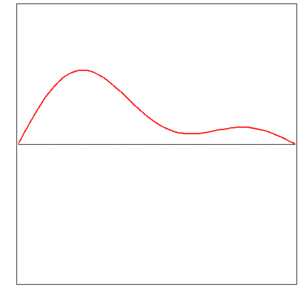User:Boris Tsirelson/Sandbox1: Difference between revisions
imported>Boris Tsirelson No edit summary |
imported>Boris Tsirelson No edit summary |
||
| Line 1: | Line 1: | ||
In [[Newtonian mechanics]], coordinates of moving bodies are functions of time. For example, the classical equation for a falling body; its height at a time ''t'' is | In [[Newtonian mechanics]], coordinates of moving bodies are functions of time. For example, the classical equation for a falling body; its height ''h'' at a time ''t'' is | ||
:<math> h = f(t) = h_0 - | :<math> h = f(t) = h_0 - 0.5 g t^2 </math> | ||
(here ''h''<sub>0</sub> is the initial height, and ''g'' is the [[acceleration due to gravity]]). Infinitely many corresponding values of ''t'' and ''h'' are embraced by a single function ''f''. | (here ''h''<sub>0</sub> is the initial height, and ''g'' is the [[acceleration due to gravity]]). Infinitely many corresponding values of ''t'' and ''h'' are embraced by a single function ''f''. | ||
| Line 9: | Line 9: | ||
:<math> y = f(x,t). </math> | :<math> y = f(x,t). </math> | ||
-- | After some speculations by Galileo (the ?? century) and mathematical interpretation by Taylor (1715), the mathematical theory of vibrating string was started by d'Alembert (communicated in 1746, published in 1749). His approach is equivalent to a [[partial differential equation]] written out by Euler in 1755, | ||
:<math> | |||
[[Wave equation (classical physics) | \frac{\partial^2 f(x,t)}{\partial x^2} = \frac{\partial^2 f(x,t)}{\partial t^2}, | ||
</math> | |||
now well-known as the one-dimensional [[Wave equation (classical physics)|wave equation]]. | |||
Revision as of 02:49, 19 November 2010
In Newtonian mechanics, coordinates of moving bodies are functions of time. For example, the classical equation for a falling body; its height h at a time t is
(here h0 is the initial height, and g is the acceleration due to gravity). Infinitely many corresponding values of t and h are embraced by a single function f.
The instantaneous shape of a vibrating string is described by a function (the displacement y as a function of the coordinate x), and this function changes in time:
Infinitely many functions ft are embraced by a single function f of two variables,
After some speculations by Galileo (the ?? century) and mathematical interpretation by Taylor (1715), the mathematical theory of vibrating string was started by d'Alembert (communicated in 1746, published in 1749). His approach is equivalent to a partial differential equation written out by Euler in 1755,
now well-known as the one-dimensional wave equation.




